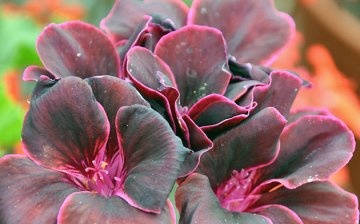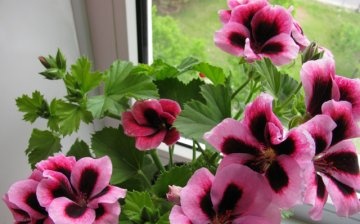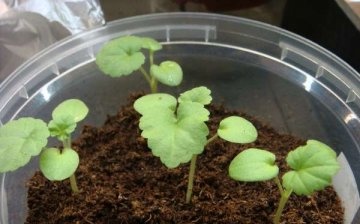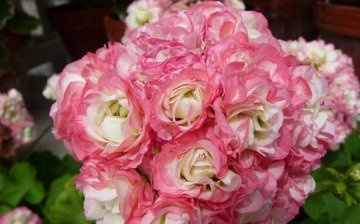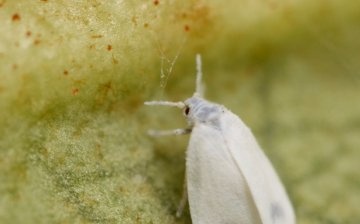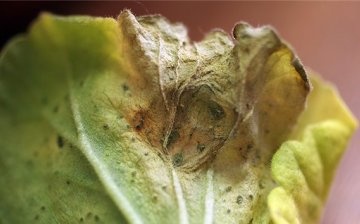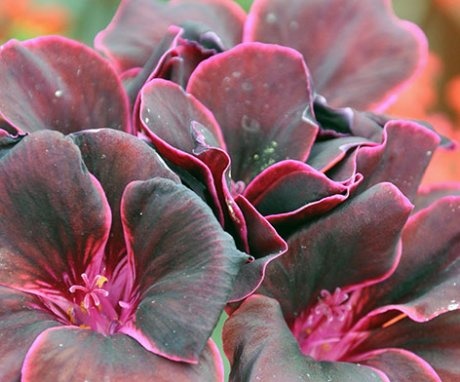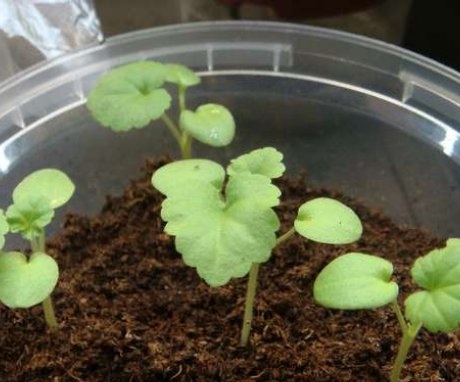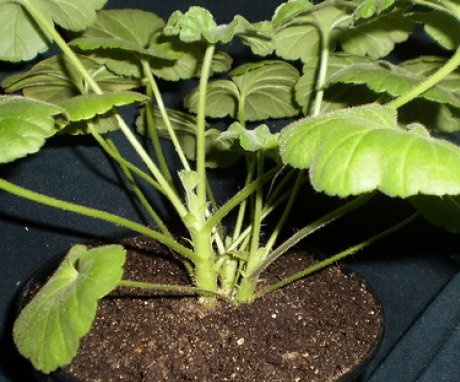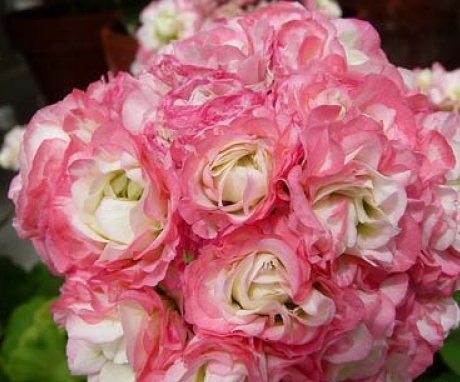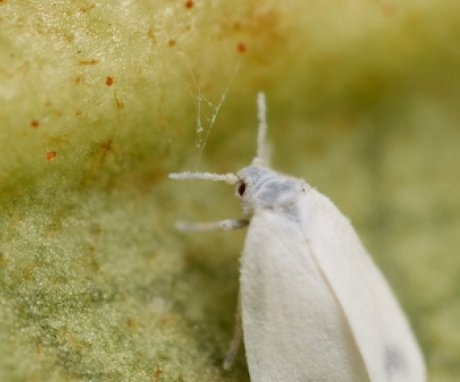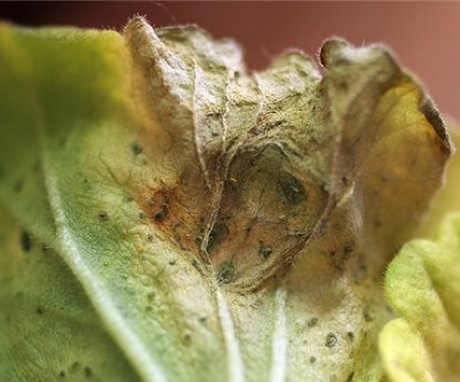Pelargonium from seeds is the easiest way to grow
Pelargonium, which, due to the structure of the seeds in everyday life, is called the crane's nose, is one of the most common flowering indoor plants. They love her for the beauty and variety of colors that have the most intricate colors and structure.
Content:
- Description of pelargonium
- Growing conditions
- Sowing seeds
- Seedling care
- Conditions for flowering pelargonium
- Pelargonium pests and the fight against them
- Plant diseases
Description of pelargonium
Pelargonium there are more than 300 types. Among them, herbaceous individuals, shrub and semi-shrub forms can be distinguished. The leaves of the flower are varied in structure: the leaf plate is whole or deeply dissected.
Flowers, red, purple, pink, snow-white, spotted, brindle, collected by an umbrella.
The plant is very similar to geranium and is a close relative of this flower. In addition to remarkable external data, pelargonium is also unpretentious in nature. And also has many medicinal qualities: soothes, relieves headache attacks, heals wounds, even purulent ones. All these qualities of an indoor flower dispose many to grow it in their home.
Growing conditions
Seeds for planting pelargonium can be purchased at a specialized store. But you can also collect seeds at home. Then, before planting, it is necessary to remove the hard shell from them with sandpaper and soak the seeds in warm water for several hours.
The planting time for pelargonium, like other indoor plants, is in the winter, the best month for this is December.
Prepared soil is poured into containers, consisting of turf with the addition of peat and sand in equal amounts. The main thing is that the soil is not acidic, so you don't need to overdo it with peat. Sow the plant into damp ground.
Sowing seeds
Seeding Seed Sectors:
- When sowing, the seeds of pelargonium are placed at a small distance from each other and sprinkled with a thin layer of soil, spraying it with warm water.
- Containers or boxes with planting material are covered with glass or polyethylene film to keep the soil moist longer.
- Every day, for a while, the film is slightly opened in order to avoid the appearance of mold.
- The room where the drawers are seedlings flower, should be light with an air temperature of at least 20 degrees.
- Shoots should appear in a week. Then the covering material is removed.
When two leaves appear on the seedlings of pelargonium transplanted in small pots. If the seedlings are noticeably elongated, then this means that there was not enough light. When transplanting, it is better to bury such plants in the soil by 1-2 centimeters, then they will become strong and will not die.
Seedling care
Pelargonium - a southern plant, therefore, light rooms are suitable for growth. And direct sunlight is not a hindrance to the flower. But even partial shade will not scare him. Although Pelargonium is thermophilic, it is not difficult for it to hold out in a low temperature, just above 10 degrees. But drafts and too low temperatures will ruin the flower. Indoor humidity also plays an important role in the life of the plant. It shouldn't be too high.
Moderation in everything: humidity, air temperature - these are the ideal conditions for pelargonium.
Water the houseplant differently depending on the season:
- In summer, abundant watering, but at the same time they constantly monitor so that excess moisture does not accumulate in the ground. Otherwise, the roots of the flower may rot.
- In the cold season, water is sparsely watered, only as the earthen coma dries up.
- When spraying other plants, care must be taken so that it does not touch the pelargonium. She doesn't like it.
Transplanted pelargonium in the event that the pot has become too tight for her. But you cannot get carried away with too spacious flowerpots, but simply take a container a little more than root system plants. Expanded clay drainage is laid at the bottom and filled with loose, light soil.
The best time to transplant: February - March.
For good nutrition, plants use top dressing in the form of complex fertilizers. They should be present in equal proportions of phosphorus, potassium, nitrogen. Nitrogen will take care of the mass of greenery, and potassium will help the formation of flowers. It is better to start feeding pelargonium at the end of winter, in February. The feeding period lasts until mid-autumn, while paying attention to the fact that fertilizers apply to moist soil and in no case prevent an overdose, otherwise the root system of the plant will die from burns.
Conditions for flowering pelargonium
Very often, even with proper care, pelargonium is not happy flowering... The reasons for this are different:
- The plant is quite healthy, the leaves and stem are pleasing with bright greenery, but something interferes with flowering. Chances are, the indoor air is hot and dry. It is necessary to transfer the flower to a cool room.
- The size of the flowerpot can cause pelargonium not to bloom. The roots of the plant should completely fill the space of the pot.
- Do not forget to feed the flower. Lack of substances such as potassium and phosphorus in pelargonium will lead to the fact that it will not bloom.
- No need to wait for flowers from the southern beauty in winter. At this time, the plant is resting, preparing for spring flowering.
Pelargonium pests and the fight against them
Pest many houseplants, aphids, also affects pelargonium. It settles on the lower part of the leaves and devours them. Getting rid of it will bring the use of insecticidal preparations.
A dangerous pest has the appearance of a small white butterfly - a whitefly.
It multiplies quickly, and settles in the same place as the aphid, feeding on the juice from the leaves of the flower. To destroy the pest, it is necessary to immediately spray the plant with soapy water and then wrap it with plastic wrap.
Plant diseases
Taking care of pelargonium is easy. Observing the rules of care, the owners of the plant will not face plant health problems. But if you ignore the advice of gardeners, then pelargonium can have such diseases:
- Gray mold affects the plant in high humidity indoors. The diseased leaves are removed and the flower is sprayed with antifungal drug... Pelargonium cannot be watered at this time.
- Rotting roots, blackness on the stem arise from too much moisture. An earthen who is not allowed to dry out between waterings. The roots rot, the flower dies. The plant can only be saved transfer healthy cuttings.
- A whitish bloom appears on pelargonium. This is powdery mildew - a fungal disease that develops in high humidity and indoor temperatures. Special drugs that eliminate the symptoms of the disease will relieve the disease.
- Pelargonium leaves sometimes become covered with rusty spots, dry up and fall off. This is a signal for treating the plant with Bordeaux liquid.
- Overfeeding with fertilizers also leads to flower disease. The leaves will turn yellow.
If the owner of the flower treats the green friend attentively, then there will be no troubles and worries. And pelargonium will delight you with bright greenery and magnificent flowering.
More information can be found in the video.




